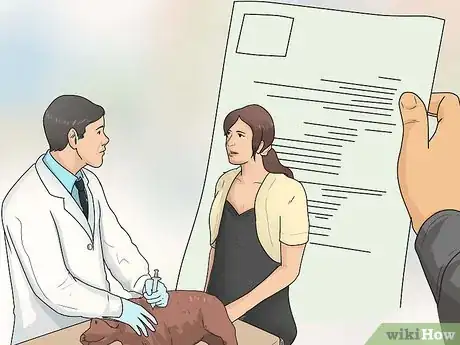This article was co-authored by Dhenu Maru. Dhenu Maru is an Immigration Lawyer, as well as the Founder and CEO of SwagatUSA, LLC. With over 10 years of experience, she specializes in family immigration and business immigration. She earned her law degree from Loyola University Chicago School of Law and her BA in Philosophy & Child Development from Tufts University. She was named a Rising Star by Super Lawyers for 2017, 2018, and 2019. She earned the title of Super Lawyer in 2021 and has been selected again for 2023.
There are 8 references cited in this article, which can be found at the bottom of the page.
This article has been viewed 98,741 times.
Bringing a pet to the United States from another country is no small task. As exciting as it may be to bring your pet with you to the US, do not let your excitement get in the way of ensuring that your pet meets the requirements for entry when you arrive. Leaving plenty of time to research the entry requirements, obtain the proper documentation, and prepare for your pet’s air travel will make the process go much more smoothly.
Steps
Preparing for Air Travel With Your Pet
-
1Consider your options for your pet’s air travel. You have several options for airline travel: having your pet travel with you on the same plane, booking your pet on another flight, or shipping your pet to the US via a licensed commercial shipper.[1] If you pet will be traveling on the same plane with you, he can travel in the cabin with you, be checked in as baggage, or shipped as cargo.[2]
- Only small dogs and cats are allowed to travel in the cabin with you and they must be securely stowed under the seat in a special carrier in front of you.[3] Ask your airline about carrier requirements if your pet will be traveling in the cabin.
- Dogs and cats checked-in as baggage or shipped as cargo must be in a sturdy carrier that will allow them enough space to comfortably stand, sit and lie down.[4]
- Air travel can be very tough on pets, but airlines do make efforts to make the flight comfortable for pets that are shipped as baggage or cargo. For example, the baggage and cargo area is pressurized and quiet.[5]
- Shipping crates can be purchased at your local pet store or through your airline. Make sure the crate is USDA-approved.[6]
- If you are not comfortable with booking your pet’s travel on a different flight, or using a commercial shipper, follow your own airline’s pet travel requirements to ensure a smooth traveling process for you and your pet.
-
2Contact your airline to learn about its pet travel requirements. It is very important for you know your airline’s pet travel requirements before you book your flight.[7] Keep in mind that pet travel requirements will vary from airline to airline, and may differ between US and non-US airlines.
- US airlines generally require a health certificate for pets traveling internationally. Some US airlines require the certificate to be no older than 10 days old, while others may require a certificate that is less than 10 days old.[8]
- Ensure that you have all the necessary medical information and permits required before entering the USA.
- Be aware that pets weighing 100 pounds or more will be considered as cargo. If your pet is around 100 pounds, check with your airline to learn if you will be charged a cargo fee.[9]
- It would also be helpful to inquire about where you should pick up your pet after the flight lands.
Advertisement -
3Attach identifying information to your pet’s carrier. This is very important! Include your contact information, as well as the address to where you will be traveling. It would also be helpful to attach a clear picture of your pet to his carrier, in case he escapes from his carrier.[10]
- Attach a ‘live animal’ sign to your pet’s carrier, along with arrows to indicate which side of the crate should face up.[11]
-
4Notify airline employees that you are traveling with a pet. From the time you check in until the time you get settled in your seat, notify as many airline staff as possible that your pet is on the plane with you. They may be able to make special accommodations to make sure your pet is comfortable and safe.[12]
-
5Maximize your pet’s comfort during the flight. In addition to making sure your pet is healthy, you can make air travel itself as comfortable for him as possible. For example, you can feed your pet a light meal about two hours before you arrive at the airport.[13] You do not want him to have a lot of food on his stomach before getting on the plane.
- If you have a dog, it is a good idea to take him for a walk before heading to the airport, and again after you check in.[14] This will give him some exercise, as well as an opportunity to go to the bathroom before getting on the plane.
- Minimize the number of layovers for your trip. Layovers may be unavoidable, depending on where you are traveling from. If you are unable to get a direct flight, an itinerary with as few layovers as possible will minimize the stress of loading and unloading your pet—for you and for him.[15]
- For long flights, it is helpful to freeze a pouch of food and water the night before your flight. Freezing the food and water will prevent a mess in your pet’s carrier, and can make it easier for you or the airline staff to feed him.[16]
Obtaining the Necessary Documentation for Your Pet
-
1Determine if you need a health certificate for your pet. A health certificate, officially known as a Veterinary Health Certificate, is not required for the entry of most pets into the US. However, most airlines, as well as some states, require health certificates.[17] Check with your airline, and the state to which you will be traveling, to get more information about health certificate requirements.
- Once you know your destination in the US, call the American Embassy in your country to find out if there are any specific entry requirements for that state.
- If you need a health certificate, it must be completed and signed by a licensed veterinarian.[18]
- There may be restrictions on how old the health certificate can be for international travel. Pay close attention to these restrictions to ensure you obtain the health certificate within the appropriate time frame before you travel to the US.
-
2Learn the entry requirements for canine rabies vaccination. A rabies vaccination is required for all dogs entering the US, including puppies and service dogs.[19] Your dog must a have rabies vaccination certificate that was completed and signed by a licensed veterinarian.[20]
- The certificate will include such information as your contact information (name and address), information about your dog (e.g., age, breed, sex), the date of rabies vaccination, and vaccine product information.[21]
- If your dog has not received a prior rabies vaccination, he will need to receive the vaccination at least 30 days before your arrival in the US.[22]
- It is acceptable for your dog to receive a booster rabies vaccination less than 30 days before arrival if he meets the following requirements: 1) at least 15 months of age, 2) received a rabies vaccine after 3 months of age, and 3) the vaccine has expired.[23]
- Your dog will not need a rabies vaccination if you are traveling from a rabies-free country in which you have lived for the past six months.[24] A current list of rabies-free countries can be found at: http://www.cdc.gov/importation/rabies-free-countries.html
- Be mindful that your dog may be denied entry if you do not have valid proof of his rabies vaccination.[25]
-
3Learn the entry requirements for pet birds. If you would like to bring your pet bird with you, be aware that bird imports are banned from some countries due to the risk avian influenza. Visit the USDA APHIS website (https://www.aphis.usda.gov/wps/portal/aphis/ourfocus/importexport) for a list of these countries.
- Even if you are not traveling from one of the banned countries, your bird will have to enter a 30-day quarantine at the USDA Animal Import Center at your expense.
- Pet birds require several pieces of documentation for entry into the US: Exporting Country Veterinary Health Certification, USDA Import Permit, and a Fish and Wildlife Certification (if necessary).
-
4Learn the entry requirements for pets other than cats, dogs, or birds. There are no restrictions or requirements on the import of rabbits, guinea pigs, hamsters, or ferrets. If you have one of these pets, they must be healthy at the port of entry. If your pet looks sick when you enter the US, he will need to be quarantined at your expense.
- If you have a pet turtle, the length of shell will be important for his entry into the US. A turtle whose shell is less than four inches (about 12 centimeters) long can be permitted for entry into the US, as long as he is not used for commercial purposes.[26]
Getting Veterinary Care Before Traveling to the US
-
1Take your pet to your veterinarian. Making sure your pet is healthy and up-to-date on his vaccinations is one of the most important things you can do to ensure a safe and smooth entry into the US for your pet. There may be a specific time frame for this visit, usually no more than seven days before you travel. Be aware that a pet who looks sick at the port of entry will need to be examined by a licensed veterinarian at the owner’s expense. [27]
- Notify your veterinarian when you schedule the appointment that you will be traveling to the US.[28] Your veterinarian will ensure that your pet is fully vaccinated and make sure you have all of the necessary veterinary documentation before you travel.
- Your veterinarian must be approved by your home country to verify the exportation of animals. Ask your vet if they are certified to do this. If not, contact the government agency in charge of the import/export of animals in your home country. They should be able to provide a list of suitably trained vets in your area.
- It is also a good idea to contact the American Embassy in your country, to ask about any specific requirements necessary to get a pet from your country into the US. This may vary depending on what diseases are common in that country, especially if they are rare or not in the United States.
-
2Check your pet’s rabies vaccination status. For the US, rabies vaccination status applies to dogs and cats. Cats are not required to have a rabies vaccination for entry. However, some states may require that your cat have a current rabies vaccination. Check the rabies vaccination requirements for the state to which you will be traveling.[29]
-
3Discuss your pet’s air travel with your veterinarian. Air travel can be difficult for pets. The anxiety of travel, along with confinement on a plane, can be very stressful for your pet. The American Society for the Prevention of Cruelty to Animals (ASPCA) strongly advises against giving sedatives to a pet for air travel, since the sedatives can negatively affect his breathing.[30]
- Talk with your veterinarian about safe options to keep your pet calm during the flight.[31]
-
4Microchip your pet. This is most applicable for dogs and cats. A microchip is not required for entry to the US,[32] but is highly recommended for air travel. The microchip will help identify your pet if he happens to escape.[33]
- Your veterinarian can microchip your pet during the appointment to check his overall health.
- Make sure that your dog or cat also has a collar and ID tag.[34]
Expert Q&A
-
QuestionCan you travel internationally with a dog?
 Melissa Nelson, DVM, PhDDr. Nelson is a Veterinarian who specializes in Companion and Large Animal Medicine in Minnesota, where she has over 18 years of experience as a veterinarian in a rural clinic. She received her Doctor of Veterinary Medicine from the University of Minnesota in 1998.
Melissa Nelson, DVM, PhDDr. Nelson is a Veterinarian who specializes in Companion and Large Animal Medicine in Minnesota, where she has over 18 years of experience as a veterinarian in a rural clinic. She received her Doctor of Veterinary Medicine from the University of Minnesota in 1998.
Veterinarian Yes you can travel internationally with a dog, but there are a number of regulations that each country requires for entry with a dog.
Yes you can travel internationally with a dog, but there are a number of regulations that each country requires for entry with a dog. -
QuestionCan I take my dog to the USA?
 Melissa Nelson, DVM, PhDDr. Nelson is a Veterinarian who specializes in Companion and Large Animal Medicine in Minnesota, where she has over 18 years of experience as a veterinarian in a rural clinic. She received her Doctor of Veterinary Medicine from the University of Minnesota in 1998.
Melissa Nelson, DVM, PhDDr. Nelson is a Veterinarian who specializes in Companion and Large Animal Medicine in Minnesota, where she has over 18 years of experience as a veterinarian in a rural clinic. She received her Doctor of Veterinary Medicine from the University of Minnesota in 1998.
Veterinarian It depends. The USA, like most countries, has certain requirements for bringing animals, including dogs, into the country. In the USA you can look at the Animal and Plant Health Inspection Service (APHIS) website for more information.
It depends. The USA, like most countries, has certain requirements for bringing animals, including dogs, into the country. In the USA you can look at the Animal and Plant Health Inspection Service (APHIS) website for more information. -
QuestionHow much does it cost to travel internationally with a dog?
 Melissa Nelson, DVM, PhDDr. Nelson is a Veterinarian who specializes in Companion and Large Animal Medicine in Minnesota, where she has over 18 years of experience as a veterinarian in a rural clinic. She received her Doctor of Veterinary Medicine from the University of Minnesota in 1998.
Melissa Nelson, DVM, PhDDr. Nelson is a Veterinarian who specializes in Companion and Large Animal Medicine in Minnesota, where she has over 18 years of experience as a veterinarian in a rural clinic. She received her Doctor of Veterinary Medicine from the University of Minnesota in 1998.
Veterinarian That is a broad question that only you can answer. You'll have to estimate the cost of the airline (or whatever means you're taking to travel) along with other fees such as for hotels, car transport etc. You should also look into a given country's rules and regulations surrounding pets.
That is a broad question that only you can answer. You'll have to estimate the cost of the airline (or whatever means you're taking to travel) along with other fees such as for hotels, car transport etc. You should also look into a given country's rules and regulations surrounding pets.
Warnings
- Your dog will be denied entry if he as a communicable disease — a disease that can be spread to people.[36] Take your pet to your veterinarian to make sure that he is free of communicable diseases.⧼thumbs_response⧽
- Your dog will also be denied entry if he has screwworms. Screwworms can be devastating to US agriculture, so your dog will need a certificate verifying he is free of screwworms if you are traveling from a country where screwworms are present.[37] Visit the USDA APHIS website (https://www.aphis.usda.gov/wps/portal/aphis/ourfocus/importexport) for a list of these countries.⧼thumbs_response⧽
- Sedatives can affect your pet's ability to breathe during a flight.[38]⧼thumbs_response⧽
- It is possible that your pet will become sick, or even die, during your flight. If your pet dies during the trip, public health officials will need to make sure that he does not have a communicable disease.[39]⧼thumbs_response⧽
Expert Interview

Thanks for reading our article! If you'd like to learn more about bringing a dog into the United States, check out our in-depth interview with Dhenu Maru.
References
- ↑ http://www.state.gov/m/fsi/tc/c10442.htm
- ↑ https://www.cdc.gov/importation/traveling-with-pets.html
- ↑ https://www.cdc.gov/importation/traveling-with-pets.html
- ↑ https://www.cdc.gov/importation/traveling-with-pets.html
- ↑ https://www.cdc.gov/importation/traveling-with-pets.html
- ↑ https://www.aspca.org/pet-care/air-travel-tips
- ↑ http://www.state.gov/m/fsi/tc/c10442.htm
- ↑ http://www.state.gov/m/fsi/tc/c10442.htm
- ↑ http://www.state.gov/m/fsi/tc/c10442.htm
- ↑ https://www.aspca.org/pet-care/air-travel-tips
- ↑ https://www.aspca.org/pet-care/air-travel-tips
- ↑ https://www.aspca.org/pet-care/air-travel-tips
- ↑ https://www.cdc.gov/importation/traveling-with-pets.html
- ↑ https://www.cdc.gov/importation/traveling-with-pets.html
- ↑ https://www.cdc.gov/importation/traveling-with-pets.html
- ↑ https://www.aspca.org/pet-care/air-travel-tips
- ↑ http://www.cdc.gov/importation/bringing-an-animal-into-the-united-states/
- ↑ http://www.pettravel.com/immigration/unitedstates.cfm
- ↑ http://www.cdc.gov/importation/bringing-an-animal-into-the-united-states/dogs.html
- ↑ http://www.cdc.gov/importation/bringing-an-animal-into-the-united-states/dogs.html
- ↑ http://www.cdc.gov/importation/bringing-an-animal-into-the-united-states/dogs.html
- ↑ http://www.cdc.gov/importation/bringing-an-animal-into-the-united-states/dogs.html
- ↑ http://www.cdc.gov/importation/bringing-an-animal-into-the-united-states/dogs.html
- ↑ https://www.cdc.gov/importation/traveling-with-pets.html
- ↑ http://www.cdc.gov/importation/bringing-an-animal-into-the-united-states/dogs.html
- ↑ http://www.cdc.gov/importation/bringing-an-animal-into-the-united-states/turtles.html
- ↑ http://www.pettravel.com/immigration/unitedstates.cfm
- ↑ https://www.cdc.gov/importation/traveling-with-pets.html
- ↑ http://www.cdc.gov/importation/bringing-an-animal-into-the-united-states/cats.html
- ↑ https://www.aspca.org/pet-care/air-travel-tips
- ↑ https://www.cdc.gov/importation/traveling-with-pets.html
- ↑ http://www.pettravel.com/immigration/unitedstates.cfm
- ↑ https://www.aspca.org/pet-care/air-travel-tips
- ↑ https://www.aspca.org/pet-care/air-travel-tips
- ↑ http://www.cdc.gov/importation/bringing-an-animal-into-the-united-states/dogs.html
- ↑ http://www.cdc.gov/importation/bringing-an-animal-into-the-united-states/dogs.html
- ↑ http://www.cdc.gov/importation/bringing-an-animal-into-the-united-states/dogs.html
- ↑ https://www.aspca.org/pet-care/air-travel-tips
- ↑ https://www.cdc.gov/importation/traveling-with-pets.html
About This Article
To bring a pet into the United States from another country, start by contacting your airline for their requirements, like whether you need a health certificate for your pet. Then, take your pet to the vet to make sure it’s healthy enough to travel, and to obtain a rabies vaccination certificate. Additionally, considering having your pet microchipped to help identify it in case it gets lost during the flight. Finally, prepare a pet carrier for the flight by labeling it with your pet’s name and your contact information. For tips from our Veterinary co-author on how to make sure your pet is comfortable during a long flight, read on!






-Step-10.webp)

































































